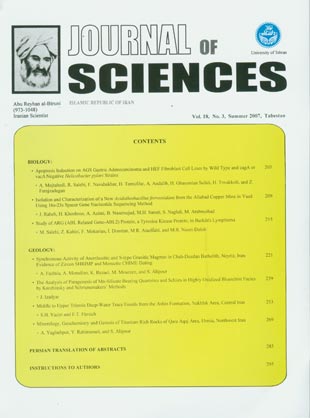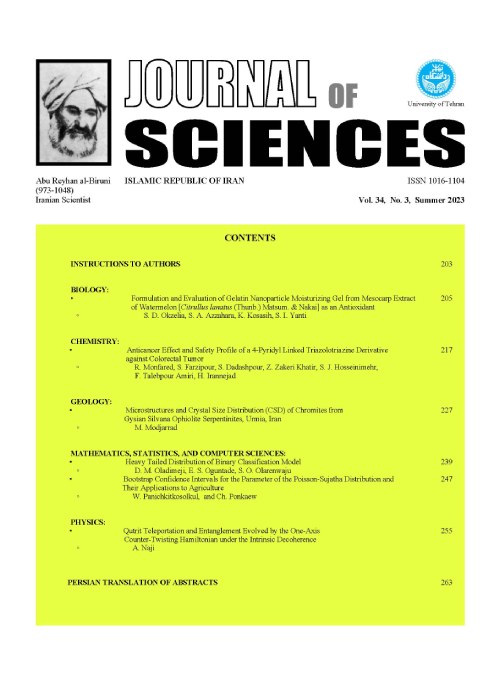فهرست مطالب

Journal of Sciences, Islamic Republic of Iran
Volume:18 Issue: 3, summer 2007
- 94 صفحه،
- تاریخ انتشار: 1386/08/25
- تعداد عناوین: 9
-
-
صفحه 203Helicobacter pylori is one of the most common pathogens affecting humans and is the major environmental factor in the development of gastric cancer increasing from 4 to 6 folds the risk of its development. Variations in cancer risk among H. pylori infected individuals may correlate to difference in H. pylori strains, variable host characteristics and specific interactions between host and microbial determinants. To determine the effect of different strains of H. pylori on cellular apoptosis we designed an in vitro model using AGS and HEF cell lines. After specified time intervals total cell proteins was extracted and subjected to SDS-PAGE and immunoblotting using anti poly ADP-ribose polymerase (PARP) antibody. Decrease in densitometric value of PARP was indicative of higher level of apoptosis. The ability of apoptosis induction in AGS and HEF cell lines by wild type, cagA negative and vacA negative strains were significantly different. The assessed apoptosis in AGS cell line co-cultured with wild type strain was 3.22±0.2 in 24 h, 2.8±0.1 in 48 h, and 2.1±0.09 in 72 h of incubation time. Similar assessment with cagA negative strains in AGS cells was 4.17±1.49 in 24 h., 3.32±0.45 in 48 h., and 2.32±0.61 in 72 h. incubation. A variation in apoptotic potential between the H. pylori strains on two cells (AGS and HEF) was observed. Based on our results, it is concluded that H. pylori strains as well as target cell types are important in pathogenesis and induction of apoptosis during a specified time interval.
کلیدواژگان: Helicobacter pylori، Apoptosis، cagA، vacA، PARP -
صفحه 215There are some evidences on involvement of ABL2 in a number of cancers, especially ABL2 overexpression was observed in Raji, a Burkitt''s lymphoma (BL) cell line. Therefore ABL2 overexpression may be involved in pathogenesis of Burkitt''s lymphoma. The aim of this study was to evaluate ABL2 significance in BL. For this purpose 20 formaldehyde fixed paraffin embedded blocks – 16BL and 4 normal lymph nodes – were used. Sections were prepared from the paraffin blocks and treat with primary and then secondary antibodies. Two proteins, ABL2 (the test protein) and GAPDH (a control house keeping protein) were studied, ABL2 was labeled green and GAPDH red. After capturing the pictures using a CCD camera, the intensity of green and red colures were measured and ratio between green/red, that demonstrate changes in ABL2 expression, were calculated. The expression of ABL2 protein in BL and normal lymph node was considerably different and BL had higher expression of ABL2 protein compared to normal lymph nodes. The mean ratio of ABL2/GAPDH in Bl and normal lymph node was 0.68 and 0.65, respectively. Like other malignancies, finding about gene expression patterns in BL seems to be helpful in future board therapeutic guidelines. Then specific inhibitors of ABL2 would be considered as new chemotherapy agents in BL treatment.
کلیدواژگان: Burkitt's lymphoma، c-abl، ABL2 protein، IHC (Immunohistochemistry) -
صفحه 221U-Th zircon SHRIMP and U-Th-total Pb monazite CHIME ages of 6 typical samples were established among different rock types outcropped into the Chah-Dozdan batholith from Iran. The zircon population displays simple internal structures in samples of the Chah-Dozdan batholith. The zircon crystals have well-preserved magmatic characteristics. In all population, the rims display younger ages than the cores, presumably due to late-magmatic crystallization. Zircon grains of anorthosites exhibit magmatic ages c. 170.5 ± 1.9 Ma and 173.0 ± 1.6 Ma. Zircon SHRIMP U-Th ages of metapelitic xenoliths and S-type granites from Chah-Dozdan pluton are c. 167.0 ± 3.1 Ma and 164.3 ± 8.1 Ma, respectively. Monazite grains are generally concordant in electron microprobe analysis and give Th-U-total Pb isochron ages in agreement with zircon SHRIMP U-Pb ages. The sub-grain analyses of monazite are plotted on the coordinates of PbO and ThO* (ThO plus the equivalent of UO2). Data points fit linearly and clearly defined an isochron which passes thorough the origin. Small patches of the S-type granites and metapelitic xenoliths yield chemical Th-U-total Pb isochron ages of monazite c. 171 ± 16 Ma and 165 ± 42 Ma, respectively. Emplacement of anorthositic magma into metapelites from the Qori metamorphic complex at mid-crustal depth resulted into fundamental contamination of this magma via breaking down of blocks of host rock into it, in the form of xenoliths within intruded magma, and s-type granite via partial melting of metapelitic xenoliths.
کلیدواژگان: Chah-Dozdan batholith، Zircon and monazite dating، Anorthosite، S-type granite، Xenoliths، Iran -
صفحه 239By Korzhinsky and Schrienemakers, methods, phase relations of Mn-Al-Ca-silicates and other minerals in highly oxidized quartzites and schists of blueschist type metamorphism have been discussed. Because, such rocks were extensively studied in central Shikoku of Japan and in Andros and Evvia islands of Greece, they have been considered as thermodynamic system for discussion. The system contains piemontite, braunite, surssasite, spessartine, pumpellyite, phlogopite, clinochlore, talc and kyanite with excess muscovite, quartz and water. System components include Al2O3, Mn2O3, MnO, CaO, MgO and K2O with excess SiO2 and H2O. Application of Korzhinsky and Schrienemakers, methods into the system gives three independent petrogenetic girds. Considering the chemographic relationships in the petrogenetic gird of [Su]-[Tlc]-[Pi], it can vividly be concluded that highly oxidized Mn-bearing quartzites or schists in blueschist facies divided to low temperature assemblage (Su + Pmp + Clin + Pi), medium temperature assemblage (Clin + Sps + Bru + Pi) and high temperature assemblage (Tlc + Sps + Br + Pi). Application to natural assemblages, show correspondence between different natural assemblages in response to variable physical conditions and their relative stability predicted from Korzhinsky and Schrienemakers, methods.
کلیدواژگان: Andros and Evvia islands of Greece، Central Shikoku of Japan، Blueschist facies، Mn-bearing silicates، Highly oxidized quartzites and schists -
صفحه 253The up to 304 m thick, turbiditic, siliciclastic Ashin Formation (Upper Ladinian to Lower Carnian?) crops out widely in the Nakhlak area of central Iran. The rocks consist mainly of turbiditic volcaniclastic sandstones and shales that were deposited in distal parts of submarine fans of the continental slope to abyssal plain. Trace fossils occur commonly in the lower parts of the turbiditic volcaniclastic sandstones and belong to 17 ichnotaxa including? Chondrites isp., Ctenopholeus kutscheri, Helminthopsis abeli, H. tenuis, H. hieroglyphica, Laevicyclus rotaeformis, Lorenzinia nowaki, Megagrapton isp., Ophiomorpha isp., Palaeophycus isp., Paleodictyon cf. maximum, Protopaleodictyon incompositum, Protovirgularia isp., and Thalassinoides isp. The trace fossil assemblage belongs to the deep-sea Nereites ichnofacies. In particular trace fossils such as Paleodictyon, Protopaleodictyon, Megagrapton and Lorenzinia indicate that the Ashin Formation represents a deep marine environment.
کلیدواژگان: Trace fossils، Triassic، Ashin Formation، Nakhlak، Central Iran -
صفحه 269Qara Aqaj titanium potential is one of the two major known titanium resources in Iran. The main host rocks of the ore body are ultramafics including wehrlite and lherzolite with minor clinopyroxenite. Qara Aqaj intrusion is composed mainly of ultramafic-mafic rocks, layered gabbro, diorite, microdiorite and some monzonite and alkali syenite. This intrusion has intruded the basement complex (amphibolite schist and gneiss), and it is covered unconformably by upper Permian sandstone and limestone. Therefore the age of intrusion can possibly be pre upper Permian. Based on structural and geochemical characteristics, Qara Aqaj intrusion can be divided into basal and main zones. The basal zone is composed of fine grain gabbro with weak layering and alteration, probably originated from a primary tholeiitic magma. This zone is enriched in Si, Na, Mg and Cr and poor in Fe, Ti and P relative to the main zone. Due to low oxygen fugacity (ƒO2) Fe-Ti minerals are not crystallized in the basal zone. It seems that the main zone that forms the main body of the Qara Aqaj intrusion is injected into the tholeiitic magma. Based on the results from drilling four ore bearing wehrlite layers varying in thickness from 1.5 m to 22 m with 33.5 m maximum combined thickness are recognized. Gabbro layers that are in contact with ultramafic layers have no economic mineralization. Some uneconomic oxide minerals are found as inclusions in silicate minerals, or open space fillings. Ore minerals in the ultramafic rocks cropping out in the study area include (in average) 10.58% wt ilmenite, 9.21% wt Ti bearing magnetite, 6.09% wt magnetite and 3.46% wt apatite (fluorapatite). The ore minerals in core samples are as follows (in average): 8.93% wt ilmenite, 8.27% wt Ti bearing magnetite, 5.52% wt magnetite and 4.25% wt apatite. The weight ratio of Fe-Ti oxide minerals to apatite varies from 4 to 30 (average 8). Qara Aqaj titanium potential can be considered as a large titanium bearing orebody. It is similar to the low grade apatite-ilmenite-magnetite deposit in the Kauhajarvi gabbro in western Finland.
کلیدواژگان: Titanium، Magmatic ilmenite، Qara Aqaj، Ultramafics، Northwest Iran
-
Page 209
With the financial protection of National Iranian Copper Industries Company, the composition of bacterial populations in Aliabad copper mine was investigated by electron microscopy and by analysis of DNA obtained from bacteria after ores laboratory cultures. This analysis consisted of the characterization of the spacer regions between the 16 and 23s genes in the bacterial rRNA genetic loci after PCR amplification. The size of the spacer region amplified from DNAs obtained from samples, were compared with the sizes of that obtained from culture of the bioleaching bacterial reference (Acidothiobacillus ferrooxidans DSMZ 583) and the 16s-23s intergenic spacer regions sequences in database. Further identification of the locale species was achieved by sequencing of the PCR product. The alignment result showed a great amount of similarity between the new bacteria and Thiobacillus ferrooxidans
Keywords: Bioleaching, Thiobacillus ferrooxidans, PCR, Molecular identification -
PERSIAN TRANSLATION OF ABSTRACTSPage 285
-
INSTRUCTIONS TO AUTHORSPage 295


